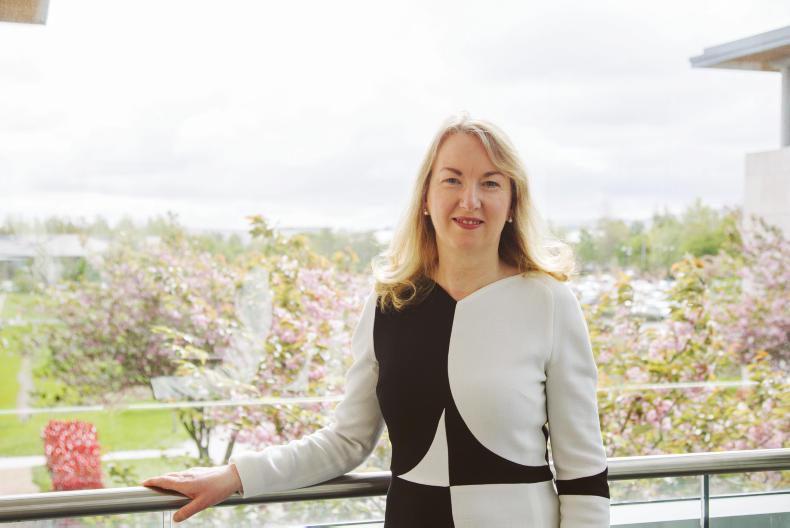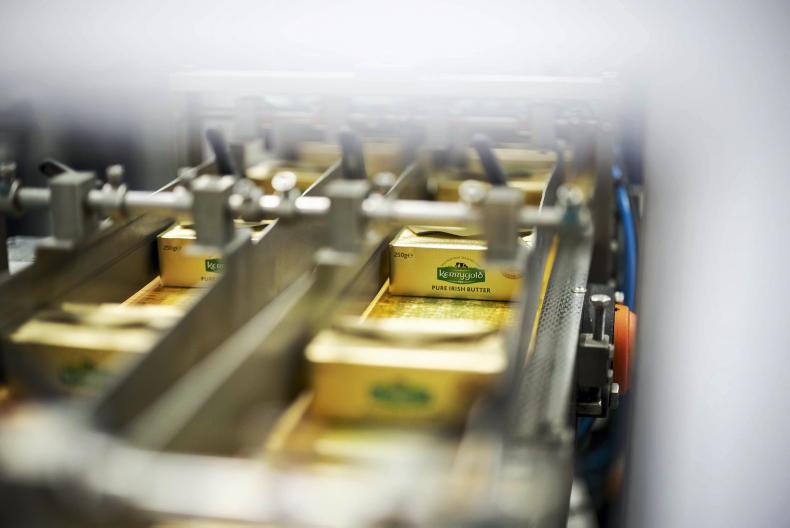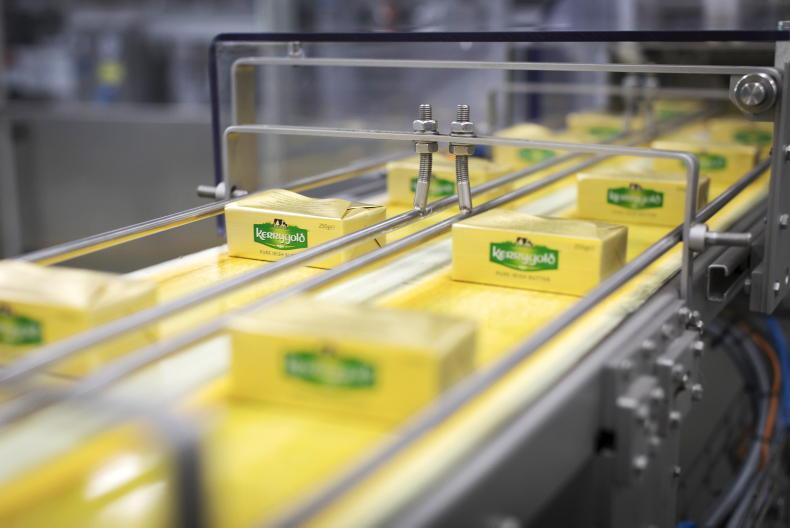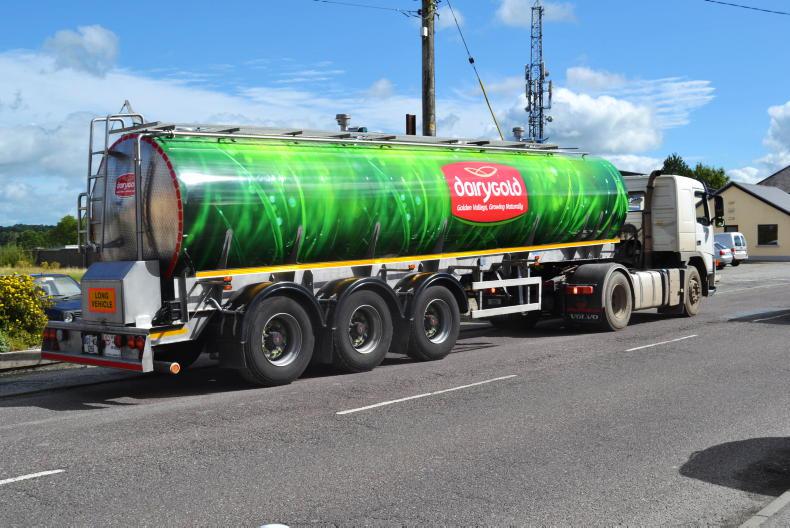“We are not going to buck dairy markets, but try take off the sharp edges” – this is how Glanbia’s managing director Siobhan Talbot sees Glanbia working for farmers.
She was speaking on the announcement of the company’s results for 2017 where it reported another year of double-digit profit growth.
While the chief of the global nutrition and ingredients business was positive on global dairy markets in the long term, she warned that markets cannot ignore the overhang of intervention and that volatility is going to continue to be a factor. There remains almost 400,000t of skim powder in intervention.
Since the start of the year, although milk production continues to be strong across Europe, dairy market prices have held up well. Butter prices, in particular, have seen further price rises over recent weeks. The spot butter price from the Dutch dairy board this week increased 12% to reach €4,850 and is now up 18% since the start of the year. This is despite the increased volume of milk coming out of the EU’s big three producers – Germany, France and the UK. The GDT fell slightly this week, dragged down by skim milk powder. This follows three consecutive rises since the start of 2018. Overall, the GDT is up almost 13% since the start of the year.
Positive
Talbot agreed markets are a “bit more positive now” but said “calling it is difficult so early in the season”. She added that “the average milk price will be less than 2017” and “an average milk price of 30c/l would be a good outcome”. Overall, she said she was positive about the long-term fundamentals of dairy, saying it is “a complete nutrient”.
“Dairy markets actually went down in the fourth quarter”, according to Talbot, who hinted the current milk price does not reflect the market. She sees supply rather than demand as the big driver of the milk price in 2018. She expects supply growth to continue in North America but is also watching what the largest producers in Europe will do. She concluded that, bar a weather shock, markets look set to be weaker in 2018.
The co-op, which owns 31.5% of Glanbia plc and 60% of Glanbia Ireland, now has two strong income streams. It will receive dividends of some €16m from Glanbia Ireland and given the announcement that the plc is increasing its dividend pay-out, the co-op will receive a further €20m.
Income
With the co-op’s income stream now significantly increased, it faces the decision as how to redistribute this money to shareholders. While Talbot would not comment on whether there would be changes, she did say “it is a co-op decision as to how the dividend is distributed to shareholders”.
She said up to now the dividend has been based on a growth rate target and that Glanbia’s board has decided to increase the payout to better reflect the performance. She said the increased dividend payout in no way “hostages Glanbia’s acquisition ambition” as “Glanbia has the capacity to spend half a billion euros on acquisitions”. While Glanbia has not completed any acquisitions in the last 12 months, after spending €168m on Amazing Grass and Body and Fit in January 2017, Talbot said Glanbia has the debt capability and a strong acquisitions pipeline. Although the company is agnostic to geography, she said it is looking at opportunities across both divisions.
On the results, Talbot said performance nutrition had a “strong fourth quarter” despite margins falling back slightly due to a “dilutive element from acquisitions”.
She said the recent plant-based acquisitions were complementary to dairy proteins and reflect the evolution of consumers. She sees the sustainable margin level in this division in the mid-teen range, “fluctuating depending on dairy markets and investment requirements at different times”.
She said Glanbia is not looking at harvesting margin in this business and looking at long-term growth. For 2018, Glanbia is guiding similar margins driven by more favourable inputs costs according to Talbot.
She said that, following the creation of Glanbia Ireland last year: “I firmly believe in the Glanbia model – more than ever.”
This sees primary dairy processing in joint venture arrangements with the plc focused on driving growth to deliver dividends to shareholders including the co-op.
Read more
Farmers set for increased payout as Glanbia increases dividend
Solid performance from both Kerry and Glanbia
“We are not going to buck dairy markets, but try take off the sharp edges” – this is how Glanbia’s managing director Siobhan Talbot sees Glanbia working for farmers.
She was speaking on the announcement of the company’s results for 2017 where it reported another year of double-digit profit growth.
While the chief of the global nutrition and ingredients business was positive on global dairy markets in the long term, she warned that markets cannot ignore the overhang of intervention and that volatility is going to continue to be a factor. There remains almost 400,000t of skim powder in intervention.
Since the start of the year, although milk production continues to be strong across Europe, dairy market prices have held up well. Butter prices, in particular, have seen further price rises over recent weeks. The spot butter price from the Dutch dairy board this week increased 12% to reach €4,850 and is now up 18% since the start of the year. This is despite the increased volume of milk coming out of the EU’s big three producers – Germany, France and the UK. The GDT fell slightly this week, dragged down by skim milk powder. This follows three consecutive rises since the start of 2018. Overall, the GDT is up almost 13% since the start of the year.
Positive
Talbot agreed markets are a “bit more positive now” but said “calling it is difficult so early in the season”. She added that “the average milk price will be less than 2017” and “an average milk price of 30c/l would be a good outcome”. Overall, she said she was positive about the long-term fundamentals of dairy, saying it is “a complete nutrient”.
“Dairy markets actually went down in the fourth quarter”, according to Talbot, who hinted the current milk price does not reflect the market. She sees supply rather than demand as the big driver of the milk price in 2018. She expects supply growth to continue in North America but is also watching what the largest producers in Europe will do. She concluded that, bar a weather shock, markets look set to be weaker in 2018.
The co-op, which owns 31.5% of Glanbia plc and 60% of Glanbia Ireland, now has two strong income streams. It will receive dividends of some €16m from Glanbia Ireland and given the announcement that the plc is increasing its dividend pay-out, the co-op will receive a further €20m.
Income
With the co-op’s income stream now significantly increased, it faces the decision as how to redistribute this money to shareholders. While Talbot would not comment on whether there would be changes, she did say “it is a co-op decision as to how the dividend is distributed to shareholders”.
She said up to now the dividend has been based on a growth rate target and that Glanbia’s board has decided to increase the payout to better reflect the performance. She said the increased dividend payout in no way “hostages Glanbia’s acquisition ambition” as “Glanbia has the capacity to spend half a billion euros on acquisitions”. While Glanbia has not completed any acquisitions in the last 12 months, after spending €168m on Amazing Grass and Body and Fit in January 2017, Talbot said Glanbia has the debt capability and a strong acquisitions pipeline. Although the company is agnostic to geography, she said it is looking at opportunities across both divisions.
On the results, Talbot said performance nutrition had a “strong fourth quarter” despite margins falling back slightly due to a “dilutive element from acquisitions”.
She said the recent plant-based acquisitions were complementary to dairy proteins and reflect the evolution of consumers. She sees the sustainable margin level in this division in the mid-teen range, “fluctuating depending on dairy markets and investment requirements at different times”.
She said Glanbia is not looking at harvesting margin in this business and looking at long-term growth. For 2018, Glanbia is guiding similar margins driven by more favourable inputs costs according to Talbot.
She said that, following the creation of Glanbia Ireland last year: “I firmly believe in the Glanbia model – more than ever.”
This sees primary dairy processing in joint venture arrangements with the plc focused on driving growth to deliver dividends to shareholders including the co-op.
Read more
Farmers set for increased payout as Glanbia increases dividend
Solid performance from both Kerry and Glanbia











SHARING OPTIONS